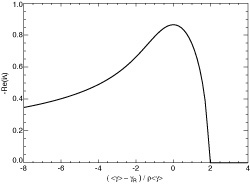Haig-Gain and Electron Beam Requirements
The FEL saturates when the electron bunch has achieved maximum modulation and all electrons radiate coherently. Early Free-Electron Lasers could not reach saturation with a single pass through an undulator. The gain can be accumulated, when the undulator is enclosed by an optical cavity and the radiation field is reflected back to seed the FEL for succeeding electron bunches. On the other hand optical cavities restrict the FEL to radiation wavelength where the losses of the cavity is smaller than the gain per single pass. To avoid this restriction the undulator length has to be several gain lengths long to obtain a large gain and to reach saturation [18].
To reduce the overall undulator length the gain length must be made as short as possible. The undulator period length is typically limited to a few centimeters and found by optimization of the gain length. Shorter values would reduce the undulator parameter and, thus, the coupling of the electron beam to the radiation field, while longer values would increase the resonant wavelength. The energy has to be increased to keep the radiation wavelength constant, which reduces the ![]() -parameter.
-parameter.
The gain length depends on the electron beam parameters as well. The gain length is reduced for a higher electron density, although there are limits on this, given by the transverse velocity spread in the electron beam. We discuss this and other 3D effects in the next section.
The gain length is based on a beam with no energy spread. Energy spread prevents bunching of all electrons at the same ponderomotive force phase, because the electrons have different longitudinal velocities and the bunching is smeared out. The bandwidth in energy, which contributes to the FEL performance, is given by the ![]() -parameter. A larger value means that the energy exchange between radiation field and electron beam is stronger. The undulator length, over which the synchronism condition must be fulfilled, is shorter. This allows a larger tolerance in the spread of the longitudinal velocity and, thus in energy. To keep the increase in the gain length reasonable the initial rms energy spread
-parameter. A larger value means that the energy exchange between radiation field and electron beam is stronger. The undulator length, over which the synchronism condition must be fulfilled, is shorter. This allows a larger tolerance in the spread of the longitudinal velocity and, thus in energy. To keep the increase in the gain length reasonable the initial rms energy spread ![]()
![]() must be
must be
![]()
Following the same argument the deviation of the mean energy from the resonant energy is limited to
![]()
Note that in the high-gain regime the gain is the largest if the beam energy is on resonance, as shown in Fig.3. This is opposite to the small-signal gain regime with no gain at <![]() >=
>=![]() R.
R.

Fig.3: Growth rate of the FEL amplification as a function of the detuning -- the deviation of the mean energy of the electron beam from the resonant energy.
Only electrons, which lie within the energy acceptance bandwidth of the FEL around ![]() R, contributes to the FEL interaction. The relative width is approximately
R, contributes to the FEL interaction. The relative width is approximately ![]() . During the FEL amplification energy is transferred from the electron beam to the radiation field. The amplification stops when most of the electrons are dropped out of the bandwidth. After that the interaction with the radiation field is negligible, because the synchronism condition is no longer satisfied. Thus the efficiency of the FEL, which is the relative amount of energy transferred from the electron beam to the radiation field is
. During the FEL amplification energy is transferred from the electron beam to the radiation field. The amplification stops when most of the electrons are dropped out of the bandwidth. After that the interaction with the radiation field is negligible, because the synchronism condition is no longer satisfied. Thus the efficiency of the FEL, which is the relative amount of energy transferred from the electron beam to the radiation field is ![]() . The saturation power of the radiation field [20] is given by
. The saturation power of the radiation field [20] is given by
![]()
Due to this scaling it is of interest to maximize the ![]() -parameter not only for reducing the needed undulator length for saturation, but also for increasing the output power level of the FEL.
-parameter not only for reducing the needed undulator length for saturation, but also for increasing the output power level of the FEL.
Because the FEL amplification is an exponential process, the major change in the electron energy occurs close to saturation, when the electrons are pushed out of the FEL bandwidth. Although the FEL amplification stops at saturation further energy can be extracted from the electron beam. For this the synchronism condition has to be extended beyond saturation. The radiation wavelength is fixed, so the undulator field or period has to be reduced to compensate for the beam energy, which has been lost due to the FEL interaction. This process to gradually reduce the undulator field or period is called tapering. Although the energy transfer during tapering is slow compared to the exponential regime of the FEL, the process has no fundamental limits beside the given length of the undulator. Experiments have shown that a tapered system can enhance the efficiency up to 40% [21].